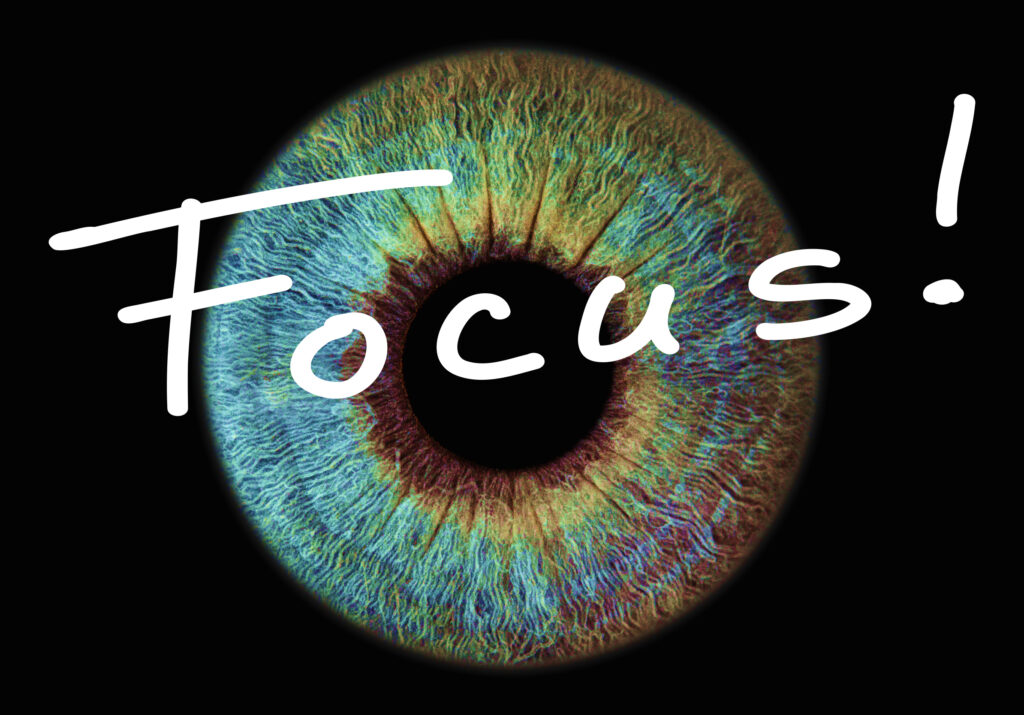Focus: 24 Strategies for Productivity and Other Good Reasons
In the first part of the focus series (click here to read it), I introduced a framework for understanding the different stages of focus, how to assess your current stage, and how these stages can either support or hinder progress in your plans and life.
Next, we’ll explore various ways to consciously shift between focus stages. This is especially useful if you find yourself repeatedly stuck in a stage that isn’t helping and want to develop techniques to proactively transition to more beneficial stages.
The Ability to Shift Along the Focus Spectrum
As we learned, focus and non-focus are neither inherently good nor bad – their value depends entirely on context, circumstances, and purpose. Each stage of focus has its own advantages and disadvantages.
Our goal is to harness focus intentionally, rather than allowing focus to control us.
But how can we achieve that? How can we consciously shift our position on the focus spectrum, adjusting to either more or less intense focus, depending on the specific situation and the objective at hand? The first step to optimizing your focus is to become aware of your current stage and determine whether your stage of focus is intentional.
For example, being unfocused might signify a period of “planned downtime,” which can be restorative, or it could indicate “involuntary distraction,” which disrupts progress. While the former brings the benefits of non-focus, the latter undermines your efforts.
The focus framework introduced in the previous article will guide you in making this distinction.
Remember, this was the framework we developed:

The second step is to cultivate the ability to deliberately shift through the five stages of focus, allowing you to leverage the benefits of each stage at the right moment.
Let’s explore strategies to help you move from a lack of focus to sharper focus – or, conversely, from overly sharp focus to relaxing and letting go.
Strategies to Shift out of Non-focus
If you lack focus and want more of it – more direction, more targeted progress – the following strategies might help. They will guide your mind, shape your thoughts, and concentrate your attention on a specific goal.
Write (Expressively)
Emotional overload often brings a sense of being torn between conflicting feelings and thoughts, making it hard to focus on any one aspect and begin processing what’s happening.
Expressive writing is a form of journaling designed to help work through difficult and overwhelming emotions. By pouring out what’s on your mind and in your soul in an unstructured, spontaneous, uncensored way, you can offload mental and emotional burdens. Sometimes, from this free flow of words, a topic will emerge, and a line of thought will take shape, guiding you out of chaos and into a calmer, more directed mental state.
Let Go Through Meditation
Meditation provides a way to let thoughts pass through without attachment. While meditating, every thought is allowed to exist—and then to leave. Meditation is a mindfulness practice. Some forms of meditation aim for “no focus” as a means of emptying the mind and achieving tranquility.
The concept of mindfulness in Zen Buddhism often involves the conscious release of focus to cultivate peace and heightened awareness. From this calm state, it becomes easier to return to deliberate focus.
De-structure
You try to tackle a problem, and everything is nicely planned out. But somehow, your plan doesn’t work. Even though your steps are clearly laid out and you try to follow them as logic dictates, you keep getting off track.
Consider this: If you’re struggling with a lack of focus, the issue might not be the absence of focus itself, but the struggle.
Perhaps the objective you’re trying to achieve isn’t suited to a structured approach. Instead of forcing yourself into linear progress (“marching”), which demands intense focus, you could embrace iterative and explorative progress (“dancing”), which allows more flexibility and opens the door to serendipitous discoveries along the way.
Practice Positive Intelligence
The concept of Positive Intelligence (PQ) introduces a framework centered around inner “saboteurs,” mental patterns that hinder us from achieving our goals. A lack of focus is the specialty of “Restless,” one of the ten identified saboteurs.
To counter these saboteurs, PQ promotes the “sage” mindset – a mental state that fosters calm decision-making and clear-headed action.
PQ includes a set of mental exercises, known as the PQ Gym, designed to help shift from your “worrier brain” to your “sage brain.” By deliberately focusing on the physical senses—sight, sound, touch, smell, and taste—the mind is redirected away from rumination and frantic, scattered thoughts, enabling more focused and purposeful progress.
Stop the Rabbit-chase
You want to work on project X, but instead of making progress, you find yourself falling into a rabbit hole, with your mind and attention drifting away from the thing you’d rather focus on. You want to write, but some detail seems to need more exploration, so you shift into research mode. One thing leads to another, and soon you’re tangled in a web of new questions and open loops, instead of closing the old ones.
Catch yourself and stop.

Find ways to remind yourself that you are chasing a fox, not a rabbit. Try to connect the dopamine hit you feel when thinking, “Oh… how interesting,” with a reminder to stay on track with what you’re working on.
One method is to keep a small notebook beside your computer, where you jot down quick notes about “future research.” This reassures your brain that “the rabbit” will be dealt with later, freeing you to turn back to the original task at hand.
March
Your mind is racing from one thing to another, and you can’t concentrate. There’s too much information in play, and you can’t seem to organize it. The more pressure you feel, the harder it is to make progress – like trying to cram everything into a box that’s too small, where nothing fits.
Go for a walk.
Seriously.

Instead of enduring the pain of overwhelm, get up from your desk and walk. Let yourself sink into the steady rhythm of putting one foot in front of the other. Keep moving forward – just march.
The physical movement acts as a kind of clock generator or metronome, naturally helping to structure and sequence your thoughts.
Breathing fresh air brings oxygen to your brain, opens your chest, and straightens your posture. Your body knows how to help you focus – if you let it.
Strategies to Sharpen Your Focus
If your focus is blurry and you want to sharpen it, build on the foundation you already have and try some of the following strategies.
Do Some Planning
If you’re feeling lost and overwhelmed by too much information or an overly large task, bring structure to the chaos. Do some serious sorting and organizing – break the topic down into modules and steps, categorize your thoughts and feelings, and organize your messy thinking.
Write a list. Plan. Decide. Then go.
Act step by step, tackling one thing at a time. Anything that gets in the way can be postponed to a dedicated “time container,” trusting it will be dealt with when the time comes.
Visualize
Lack of focus often stems from a lack of clarity. Without knowing your destination, you won’t find the way.
Use your imagination to preempt the outcome you want to achieve. Create a vivid picture of your future state and let the goal pull you forward, instead of you constantly pushing for it. Knowing where you want to arrive makes it easier to follow paths that lead in the right direction.
Step Back and Out
When immersed in tangled trains of thought, you can’t see the forest for the trees. Step back and try to view the situation from a distance. Seek to understand the bigger picture:
Why, What, Who, When, Where, What For.
Take a 30,000-foot view of what you’re trying to achieve within the larger context, the longer timeframe, the broader purpose. Seeing the bigger picture clarifies topics and relationships, providing you with a map of the territory you’re working to conquer.
Step Forward and In
Sometimes, you lose focus because you’re looking at the task at hand from too far away. Too much forest, not enough trees. Step closer to the problem to better understand what needs to be done right now, right here, and right next. Narrow your focus to see things in richer detail and deeper depth.
Narrow Your Input Channels
Have you ever noticed how programmers often work with headphones on? There’s a reason for it.
You can apply the same principle: narrow your input channels to concentrate on the mental work needed to make progress.
Put on your blinders – use the hood of your hoodie.
Put on your deafening device – your noise-canceling headphones.
Limit your visual space – shine a spotlight on your work surface while keeping the surrounding environment dim.
Eliminate unnecessary input from your senses to sharpen your focus.
Strategies to “De-neutralize” Focus
If you find yourself caught in the middle—somewhat focused but lacking enthusiasm and struggling with indifference—you can work on the intensity of your focus (trying to increase or decrease it using strategies from the previous and subsequent chapters). Alternatively, you could shift the direction of your focus, as explained here.
Take Sides
When faced with two or more different perspectives on a problem, options to choose from, paths to follow, or arguments in a discussion, you could cycle through them sequentially instead of trying to tackle them all at once.
Move to one side of the argument and dive deep into the emotions, reasons, and objectives involved. Immerse yourself in one of the available options, then switch to the other. Direct your attention to each side and explore how this approach expands your perception.
Actively Moderate
Instead of passively lingering in the middle, invite both (or all) sides into a constructive debate with a genuine strive for progress. This can apply to “real” people you’re dealing with, or to the “inner” parts of yourself if the indifference lies within your own mind. Actively mediate between the parties involved.
Help uncover hidden needs and fears so they can be deliberately addressed. Strive for transparency and clarity. Dig deeper beneath the surface. Be a mediator.
Increase the Stakes
Sometimes, indifference stems from a lack of passion or energy. Add some drama to the situation. Increase your emotional involvement by exploring the impact of one option versus the other on your life circumstances. Play it forward: What if X? What if Y?
The driver for focus might lie further out in one of the options.
Remember Your Values
What’s important to you? How does your indifference relate to your core values? Is there any conflict when you relate your in-between state to those values, either because one is being violated or because opposing responses arise from different values? Go deep and seek clarity.
Strategies to Soften Strong Focus
If you feel you’re focusing too much – caught in rumination or feeling the impact of obsessive concentration – you might consider strategies to loosen or soften your focus, letting go of the limitations that excessive focus can cause.
Strategize for Balance
Too sharp a focus can lead to imbalance across different areas and perspectives of your life. An overemphasis on work can harm your personal relationships and family life. Focusing too much on exercise might limit the depth of friendships you can maintain.
You can work through exercises like the Life Wheel, which will help you more fairly allocate time, energy, and effort to all the important areas of your life.
Go Astray
If you’re at risk of narrow-mindedness, as your mind circles around the same topic repeatedly and you feel you’re running out of ideas from the thinking material you’ve gathered, try making a conscious mental shift into unrelated areas to draw inspiration from another field.
For instance, if you’re working on a tech-related project, move your thinking away from technology and into nature. What concepts and solutions exist in nature that might be applicable to your tech problem?
Many beautiful products and solutions were inspired by cross-disciplinary thinking, such as the lotus effect, Velcro fasteners, GPS, and more.
Perhaps lateral thinking will benefit you as well.
Make Decisions
Sometimes, we don’t focus on finding a solution but on finding the “perfect” solution. Once a good solution is found, you can’t let go; your focus shifts to optimizing it or finding an even better one. One example is when you can’t stop researching for “the best” product online, unable to just go with the first or second one you find. While this diligence might be appropriate for products that must meet very specific criteria, it’s unnecessary for day-to-day items that you’ll need to replace soon anyway.
Stop this unproductive focus by consciously narrowing down the available options in your thinking. Make decisions and abandon all “alternative routes.”
Reduce the complexity by cutting down the number of variables in the equation. This will free up mental resources otherwise occupied by perfectionism.

Lower the Bar
Striving for perfectionism means we’ll never succeed. You can always optimize further. You can always do better.
Here’s an easy way to preempt perfectionism right from the start:
Before you begin a task, define your success criteria. Set a quality standard that is “good enough,” then work toward it and move on once you’ve reached it.
Practice being okay with imperfection. Consider the “cost” of perfection, including the opportunity cost of not being able to do other things.
Postpone Your Thinking
Focus occupies mental resources. If you are too focused on a certain topic or outcome, your mind becomes preoccupied with it, leaving no room for other things.
While this is useful during your dedicated working hours, it becomes detrimental if that focus doesn’t stop once your workday is over.
If you cannot shift your mind away from the problem you’ve been working on, try the postponement technique. The moment your thoughts drift back to your work, catch yourself. Acknowledge the importance of the issue at hand, but instead of continuing to dwell on it, deliberately postpone dealing with it. Set aside a dedicated time block for your thinking and schedule it in your calendar – ideally, that should be the next working day when you’ll officially return to the project.
Strategies to Break „Hyperfocus“
Focus becomes detrimental or even dangerous if it leads to obsessive behavior. Over-occupying your mind can result in neglecting both the environment and your own needs. To break free from hyperfocus, try the following strategies.
Create Competition
This is one of my favorite methods for shifting my mind away from something I’m obsessing over. Here’s how it works:
Offer your mind an alternative focus of similar intensity, but one that is closer to your survival instincts. OF COURSE, you should do this in a safe setting to avoid injury or worse. But by tricking your mind into assuming danger, you create enough motivation to shift away from the project you’re hyperfocused on.
Some suggestions:
Do something dangerous. Force your mind to focus on survival. Go rock climbing – dependent on your proficiency as a climber, the shift might occur around the 9th degree latest If you are a beginner, this will help you focus on the climb rather than the topic you’re ruminating about.
Do something challenging. Push yourself outside your comfort zone. For example, if public speaking is difficult for you, try improvisational theater. If you enjoy crafting and knitting, try a complex knitting pattern. The challenge will occupy your mind and redirect energy from your hyperfocus.
Get some adrenaline. Adrenaline released into our bodies to prepare us for survival. Use this to your advantage. Ride a thrilling rollercoaster, try a bungee jump, or go white-water rafting. Do something that gives you an adrenaline rush.
Do something you are afraid of. Go beyond just a challenge do something that scares you. Schedule that long-overdue dental surgery, have that difficult conversation with your spouse, or ask your crush out to dinner.

Exercise Paradoxical Intention
Paradoxical intention is a therapeutic approach from Logotherapy, developed by Viktor Frankl.
The basic idea is to “desire what you fear.”
If you fear fainting in an overcrowded underground train, wish that you’d faint. If you fear forgetting your words during a presentation, wish that you would forget them.
This may sound counterintuitive – and perhaps even a little unsettling – but the brain cannot hold both desire and fear of the same thing simultaneously. Even if your logical brain knows that your fabricated desire is not genuine, the fear will be “confused” by the desire, breaking old patterns of focus.
Let Go
Hyperfocus is a form of mental clinging. Your mind holds tightly to a certain thought or idea, going in circles, ruminating about a person or experience.
For instance, you feel deeply hurt by how someone treated you, and you can’t stop being upset. How could they say that to you? Your hyperfocus on this question keeps you clinging to your hurt and wound.
The only way to stop clinging is to open your grip and let go.
Let go of anger, regret, and rage. Forgive. Accept.
Allow yourself to heal.
Reframe
When our mind is stuck, our thinking loops through the same patterns over and over again. Repetition only strengthens these patterns further. Beliefs become more ingrained.
You could try deliberate reframing.
One simple technique is to take a specific belief and swap out individual words to see what shifts.
For example, if you’re obsessing over a conflict with another person, try transitioning from “HE hurt me” to “I hurt HIM” or even “I hurt ME.” You can achieve interesting focus shifts using this method.
Summary
Let’s wrap it up.
All stages of focus—whether it’s the complete absence of focus or laser-like hyperfocus—can be either good or bad. It all depends on the circumstances.
A first step to optimizing focus is to become aware of the five stages and recognize which stage you’re in.
The second step is to consciously shift along the focus spectrum, deliberately moving in or out of focus at will, using any of the techniques we’ve explored above.

Get in Touch
What’s on your mind today? Share your thoughts and let’s connect.

